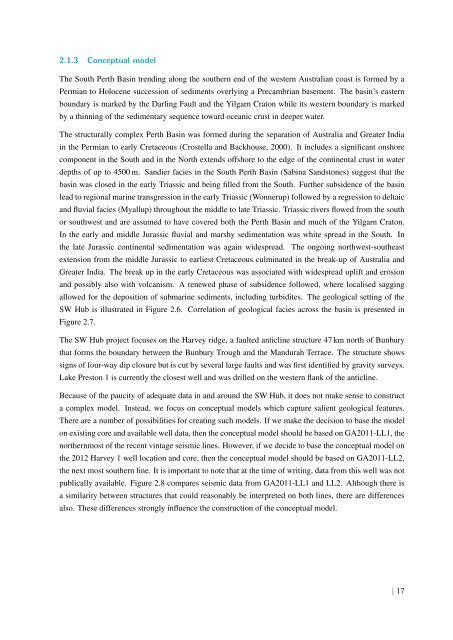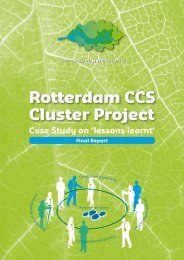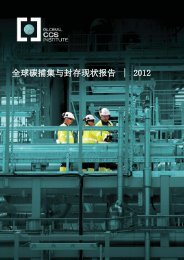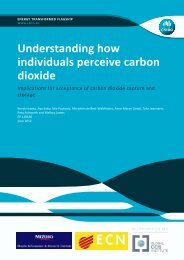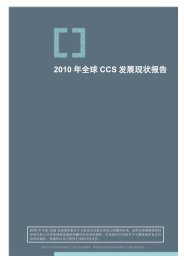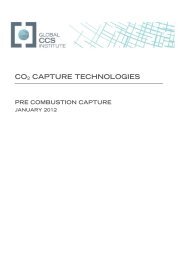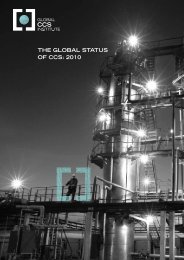Download the document - Global CCS Institute
Download the document - Global CCS Institute
Download the document - Global CCS Institute
- No tags were found...
You also want an ePaper? Increase the reach of your titles
YUMPU automatically turns print PDFs into web optimized ePapers that Google loves.
2.1.3 Conceptual modelThe South Perth Basin trending along <strong>the</strong> sou<strong>the</strong>rn end of <strong>the</strong> western Australian coast is formed by aPermian to Holocene succession of sediments overlying a Precambrian basement. The basin’s easternboundary is marked by <strong>the</strong> Darling Fault and <strong>the</strong> Yilgarn Craton while its western boundary is markedby a thinning of <strong>the</strong> sedimentary sequence toward oceanic crust in deeper water.The structurally complex Perth Basin was formed during <strong>the</strong> separation of Australia and Greater Indiain <strong>the</strong> Permian to early Cretaceous (Crostella and Backhouse, 2000). It includes a significant onshorecomponent in <strong>the</strong> South and in <strong>the</strong> North extends offshore to <strong>the</strong> edge of <strong>the</strong> continental crust in waterdepths of up to 4500 m. Sandier facies in <strong>the</strong> South Perth Basin (Sabina Sandstones) suggest that <strong>the</strong>basin was closed in <strong>the</strong> early Triassic and being filled from <strong>the</strong> South. Fur<strong>the</strong>r subsidence of <strong>the</strong> basinlead to regional marine transgression in <strong>the</strong> early Triassic (Wonnerup) followed by a regression to deltaicand fluvial facies (Myallup) throughout <strong>the</strong> middle to late Triassic. Triassic rivers flowed from <strong>the</strong> southor southwest and are assumed to have covered both <strong>the</strong> Perth Basin and much of <strong>the</strong> Yilgarn Craton.In <strong>the</strong> early and middle Jurassic fluvial and marshy sedimentation was white spread in <strong>the</strong> South. In<strong>the</strong> late Jurassic continental sedimentation was again widespread. The ongoing northwest-sou<strong>the</strong>astextension from <strong>the</strong> middle Jurassic to earliest Cretaceous culminated in <strong>the</strong> break-up of Australia andGreater India. The break up in <strong>the</strong> early Cretaceous was associated with widespread uplift and erosionand possibly also with volcanism. A renewed phase of subsidence followed, where localised saggingallowed for <strong>the</strong> deposition of submarine sediments, including turbidites. The geological setting of <strong>the</strong>SW Hub is illustrated in Figure 2.6. Correlation of geological facies across <strong>the</strong> basin is presented inFigure 2.7.The SW Hub project focuses on <strong>the</strong> Harvey ridge, a faulted anticline structure 47 km north of Bunburythat forms <strong>the</strong> boundary between <strong>the</strong> Bunbury Trough and <strong>the</strong> Mandurah Terrace. The structure showssigns of four-way dip closure but is cut by several large faults and was first identified by gravity surveys.Lake Preston 1 is currently <strong>the</strong> closest well and was drilled on <strong>the</strong> western flank of <strong>the</strong> anticline.Because of <strong>the</strong> paucity of adequate data in and around <strong>the</strong> SW Hub, it does not make sense to constructa complex model. Instead, we focus on conceptual models which capture salient geological features.There are a number of possibilities for creating such models. If we make <strong>the</strong> decision to base <strong>the</strong> modelon existing core and available well data, <strong>the</strong>n <strong>the</strong> conceptual model should be based on GA2011-LL1, <strong>the</strong>nor<strong>the</strong>rnmost of <strong>the</strong> recent vintage seismic lines. However, if we decide to base <strong>the</strong> conceptual model on<strong>the</strong> 2012 Harvey 1 well location and core, <strong>the</strong>n <strong>the</strong> conceptual model should be based on GA2011-LL2,<strong>the</strong> next most sou<strong>the</strong>rn line. It is important to note that at <strong>the</strong> time of writing, data from this well was notpublically available. Figure 2.8 compares seismic data from GA2011-LL1 and LL2. Although <strong>the</strong>re isa similarity between structures that could reasonably be interpreted on both lines, <strong>the</strong>re are differencesalso. These differences strongly influence <strong>the</strong> construction of <strong>the</strong> conceptual model.| 17


